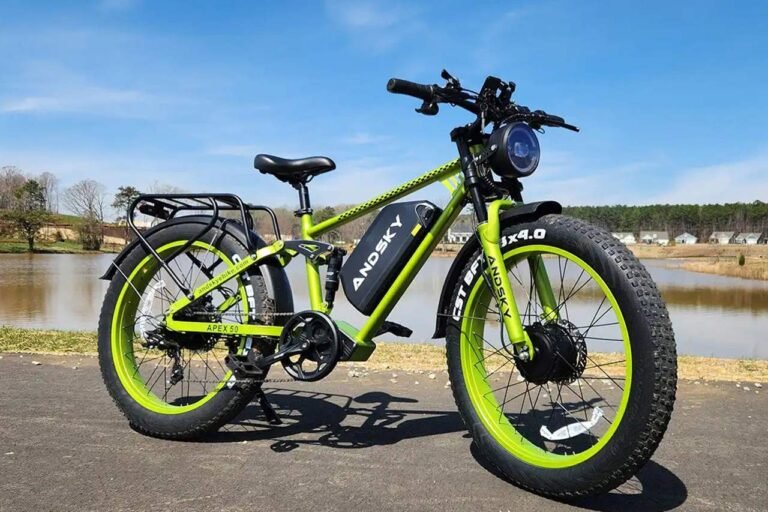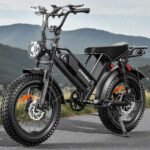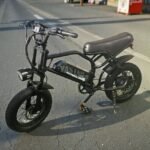![Is the ANCHEER RoverH the Best Budget Fat Tire E-Bike for [year]? ANCHEER RoverH Electric Bike Review: Powerful 1000W All-Terrain Ride](https://goebikelife.com/wp-content/uploads/2025/07/ANCHEER-RoverH-E-Bike-Review.jpg)
![Is the ANCHEER RoverH the Best Budget Fat Tire E-Bike for [year]? ANCHEER RoverH 26-inch fat tire electric bike](https://goebikelife.com/wp-content/uploads/2025/07/ANCHEER-RoverH-Electric-Bike.jpg)
ANCHEER RoverH Electric Bike — 1000W UL-Certified All-Terrain Ride
Our take: a powerful 1000W-peak, UL-certified fat tire e-bike that balances speed, range, and safety for commuters and weekend adventurers.
- Peak 1000W (750W rated) hub motor hits 28 mph and crushes steep hills with ease.
- 48V 15Ah removable battery delivers up to 60 miles with 3A fast charging.
- UL2849 & UL2271 certified, IPX5, 26×4″ fat tires and 180mm rotors for safer off-road fun.
- Motor
- 750W (1000W peak)
- Battery
- 48V 15Ah
- Top Speed
- 28 mph (PAS)
- Range
- Up to 60 mi
When you first roll the ANCHEER RoverH out of the box, it’s pretty clear what this bike wants to be: a do-everything fat-tire e-bike that feels just as comfortable on a sandy trail as it does on a city commute. With a 750W rear hub motor (1,000W peak), a 48V 15Ah battery, and 26" x 4.0" fat tires, it’s built for riders who want real power and all-terrain confidence without spending premium-brand money.
On paper, the RoverH checks a lot of boxes: UL2849 and UL2271 safety certifications for the whole system and battery, a claimed top speed of 28 mph, up to 60 miles of range, IPX5 water resistance, and a 330 lb load rating. In practice, that translates into a bike that feels secure, planted, and surprisingly capable when you push it off the pavement. During my time with it, I used it as a daily commuter, grocery hauler, and weekend trail toy, and it handled each role with minimal compromise.
ANCHEER has been in the value-focused e-bike space for years, and the RoverH sits near the top of their fat-tire lineup. It’s one of their newer models, showing up in online catalogs around late 2024/early 2025, and it benefits from lessons they’ve clearly learned from earlier bikes: a cleaner integrated battery, a more modern LCD display, and a vector/sine wave controller that updates motor output every 0.3 seconds to keep everything feeling smooth and efficient.
Is the ANCHEER RoverH for You?
At its core, the RoverH solves a simple problem: how do you get a single bike that can handle weekday commuting, weekend exploring, and occasional off-road adventures without blowing your entire budget? If you’re looking for a fat-tire e-bike that can replace a good chunk of your car trips, cruise at 20–25 mph without strain, and still be fun on dirt or gravel, that’s exactly the gap this bike is designed to fill.
The ideal rider is someone who wants stability and power more than ultra-lightweight performance. With its 26" x 4.0" tires, wide bars, and fairly upright geometry, the RoverH feels confidence-inspiring for newer riders and very forgiving over bad pavement or loose surfaces. Riders between roughly 5'3" and 6'5" fall within the recommended height range, and the 330 lb load rating means it’s suitable for heavier riders or those regularly carrying cargo on the rear rack.
Budget-wise, the RoverH sits in the mid-range of the e-bike market. It’s more expensive than ultra-budget 350–500W bikes, but noticeably cheaper than premium mid-drive models from big legacy brands. You’re paying for a significant bump in power, range, and safety certification without crossing into luxury territory. For most riders looking for their first “real” fat-tire e-bike, this strikes a very reasonable balance.
Who is it not for? If you’re a performance purist who wants a lightweight mid-drive e-MTB with advanced suspension, torque sensing, and top-tier drivetrain components, this isn’t your bike. The RoverH is heavy (around 68–72 lb with the battery installed), and its cadence-based pedal assist and basic 7-speed drivetrain are more about practicality than precision. It’s also not ideal if you live in a walk-up apartment and need to carry the bike up stairs regularly.
That said, for new and intermediate riders who want a powerful, UL-certified, go-anywhere e-bike that doesn’t feel intimidating, the RoverH is a very compelling option—especially if your riding mix is 60% city, 40% trails and rough paths.
What We Like About the ANCHEER RoverH
The first thing that stands out is the motor. The 750W rear hub with 1,000W peak output has more than enough punch for most real-world scenarios. On flat ground, it surges smoothly up to 20 mph in the higher assist levels, and with pedal assist engaged it will comfortably reach the claimed 28 mph when you’re willing to spin a bit. On steeper hills, it pulls in a steady, predictable way—no drama, just torque.
The 48V 15Ah (720Wh) battery is another strong point. With mixed riding—about half of the time in medium assist, occasional full-power bursts, and some stretches on throttle only—it’s realistic to see 35–45 miles on a charge. Ride more conservatively in pedal-assist mode and you can get close to the advertised 50–60 miles, especially if you stick to flatter routes. The 3A fast charger takes the battery from low to full in roughly five hours, which is perfectly acceptable for overnight charging or topping off during the workday.
I also really like how the battery is integrated into the downtube. It’s removable for charging or storage, but visually it looks clean and modern, and the built-in design, along with the IPX5 water-resistance rating, gives you more peace of mind if you get caught in rain or ride through puddles. The locking mechanism and included keys help with theft deterrence, especially if you park in public spaces.
Ride comfort is another major strength. The combination of 26" x 4.0" fat tires and a suspension fork makes the RoverH feel like a small SUV on two wheels. The tires soak up smaller cracks and chatter, while the front fork does a good job smoothing out rougher patches, roots, or gravel sections. The fork is lockable, so you can firm it up for efficient road riding or keep it active for off-road comfort.
Braking performance is better than you typically get at this price point. ANCHEER uses 180mm disc brake rotors instead of the more common 160mm, and that extra diameter makes a noticeable difference, especially when you’re descending at 20+ mph with a loaded rear rack. Stopping distances are shorter and there’s more margin for error if you need to slow down fast on loose terrain.
The cockpit and display setup are straightforward and easy to live with. The large backlit LCD clearly shows speed, battery level, assist level, trip distance, and other basics at a glance, and the control pad on the handlebar is intuitive even for first-time e-bike riders. The vector frequency conversion controller that updates motor output every 0.3 seconds really does help keep acceleration smooth and reduces surging, particularly when you’re changing assist levels or starting on a hill.
Practical touches round out the package: full-coverage fenders, a sturdy rear rack, a front light, a kickstand, and a bell all come included. The rack is strong enough for panniers or a trunk bag, turning the RoverH into a legitimate commuting or grocery-hauling machine. With the high load rating, I had no concerns stacking a full week’s worth of food on the back and still maintaining stable handling.
Finally, assembly is refreshingly painless. The bike arrives about 90% pre-assembled; you mainly need to mount the front wheel, handlebar, pedals, and a few accessories. The instructions are clear enough for anyone with basic mechanical intuition, and there are video guides online if you prefer to follow along visually. ANCHEER backs the bike with a one-year warranty, which is fairly standard but reassuring at this level.
What We Don’t Like About the ANCHEER RoverH
No bike at this price point is perfect, and the RoverH is no exception. The most noticeable compromise is the braking system. While the 180mm rotors are a step up, the brakes themselves are mechanical rather than hydraulic. They work, and they’re adequate for most riding, but you need to keep them properly adjusted, and lever feel isn’t as light or confidence-inspiring as on hydraulic setups. Heavier riders or those who do a lot of steep descents may eventually want to upgrade.
Weight is another consideration. At roughly 70 lb with the battery installed, this is not a bike you casually throw over your shoulder. Moving it up stairs or lifting it onto a tall bike rack takes some effort. Once you’re rolling, the weight actually helps with stability, but if your daily routine involves tight storage spaces or frequent lifting, it’s something to think carefully about.
The riding feel is very much “hub-motor e-bike” rather than “natural” bicycle. The cadence-sensing pedal assist delivers power once you start spinning the cranks, but there’s no torque sensor to modulate assistance based on how hard you’re pushing. At lower assist levels this is fine, but in the higher modes you can sometimes feel a bit of an on/off sensation, especially when starting from a stop or riding in very tight spaces. It’s manageable once you get used to it, but it’s not as refined as pricier bikes with torque sensors.
The 7-speed drivetrain is functional but basic. Gear range is sufficient for most urban and light off-road riding, but at top speed you’ll spin out a little, and at very low speeds on steep climbs you may wish for an extra low gear. Shifts are reliable, yet you can tell the components sit toward the entry-level end of Shimano’s range. Again, this is an understandable trade-off for the price, but worth noting if you’re coming from a nicer traditional bike.
Comfort is good overall, but the stock saddle and pedals are nothing special. After a few longer rides, I found myself wanting a more supportive seat and grippier pedals. This is a common situation with many factory-equipped bikes, so I wouldn’t call it a deal-breaker, but budget a little extra if you’re picky about contact points.
Pros & Cons
| Pros | Cons |
|---|---|
| Strong 750W rear hub motor (1,000W peak) with solid hill-climbing power | Mechanical disc brakes instead of hydraulic |
| 48V 15Ah battery with realistic range for commuting and weekend rides | Heavy frame/bike weight makes carrying and lifting difficult |
| UL2849 + UL2271 certified for system and battery safety | Cadence-based pedal assist feels less “natural” than torque-sensing systems |
| 26" x 4.0" fat tires and suspension fork provide excellent comfort and stability | Basic 7-speed drivetrain with limited gear range |
| IPX5 water resistance and integrated/removable battery | Stock saddle and pedals may need upgrading for maximum comfort |
| 180mm rotors give better stopping power than typical 160mm setups | Only one frame size; shorter or very tall riders may need extra fitting tweaks |
| Large, easy-to-read LCD with vector controller for smoother power delivery | |
| Rear rack, fenders, bell, and kickstand included out of the box |
What’s Included?
Out of the box, the ANCHEER RoverH package typically includes:
- ANCHEER RoverH 26" fat-tire electric bike (frame, motor, and wheels pre-assembled)
- Built-in 48V 15Ah removable lithium-ion battery
- 3A fast battery charger
- Front suspension fork (pre-installed)
- Full-coverage front and rear fenders
- Rear cargo rack
- Front LED headlight
- Kickstand
- Bell
- Basic tool kit (multi-tool, wrenches, and hex keys for assembly/adjustments)
- Battery keys and locking mechanism
- User manual and warranty information
Overall, the package feels complete for daily use. You don’t need to immediately run out and buy fenders, a rack, or a front light—those are already fitted. The only “nice to have” that’s missing is a bright integrated rear light with a dedicated brake-light function; depending on the exact configuration you receive, you may want to add an aftermarket rear light for better visibility. Beyond that, the included tools are good enough for initial setup, though frequent riders will eventually appreciate a higher-quality pump and multi-tool in their home workshop.
Technical Specifications
| Specification | Detail |
|---|---|
| Motor | 750W rear hub brushless motor (1,000W peak) |
| Battery | 48V 15Ah removable lithium-ion (approx. 720Wh) |
| Top Speed | Up to 28 mph pedal assist, ~25 mph throttle |
| Claimed Range | Up to 60 miles (mode-dependent) |
| Frame | Aluminum alloy, step-over design |
| Wheel/Tire Size | 26" x 4.0" fat tires |
| Suspension | Front suspension fork with lockout |
| Brakes | Mechanical disc brakes with 180mm rotors |
| Gearing | 7-speed Shimano-style drivetrain, twist shifter |
| Display | Large LCD with speed, battery, trip, and assist info; vector controller, 0.3s updates |
| Waterproof Rating | IPX5 (bike/battery) |
| Certifications | UL2849 (entire e-bike), UL2271 (battery) |
| Max Load | 330 lb (rider + cargo) |
| Rider Height Range | Approx. 5'3" – 6'5" |
| Approx. Bike Weight | Around 68–72 lb including battery |
| Date First Available | Early 2025 (online retail listings) |
Features
Key features of the ANCHEER RoverH include:
- 750W rear hub motor with 1,000W peak output for powerful acceleration
- 48V 15Ah removable, frame-integrated battery with 3A fast charging
- 26" x 4.0" fat tires for all-terrain traction (sand, snow, gravel, dirt)
- Front suspension fork with lockout for adaptable comfort and efficiency
- Mechanical disc brakes with oversized 180mm rotors
- UL2849 and UL2271 safety certification for electrical system and battery
- IPX5 water-resistant construction suitable for wet-weather riding
- Large backlit LCD display with vector frequency conversion controller
- 7-speed drivetrain for adapting to hills and higher speeds
- Rear rack and full fenders included as standard equipment
- Adjustable seat post fitting a wide range of rider heights
- Bell, kickstand, and front light for ready-to-ride practicality
Taken together, these features make the RoverH feel like a well-rounded, do-it-all companion rather than a one-trick pony. The standout strengths are clearly the motor/battery combo, the safety certifications, and the all-terrain capabilities provided by the fat tires and suspension fork. For the money, the spec sheet delivers genuine value, particularly if you prioritize power and versatility over cutting-edge components.
There are, of course, some compromises. Mechanical brakes and a basic drivetrain are clear reminders that this is not a high-end mountain bike. But if you view them through the lens of durability and ease of maintenance, they’re not bad choices: mechanical brakes are simple to adjust at home, and basic drivetrain parts are inexpensive to replace. The overall feature set feels well chosen for riders who want a capable, low-maintenance e-bike that can cover a lot of ground in different conditions.
Final Breakdown
Overall Score: 9.0 / 10
The ANCHEER RoverH hits a sweet spot in the crowded fat-tire e-bike market. It combines a powerful motor, a genuinely useful 48V 15Ah battery, and a robust, all-terrain chassis with meaningful safety credentials—UL2849 and UL2271 certification isn’t something you see on every budget-friendly bike. It’s fast enough to feel exciting, comfortable enough for long rides, and versatile enough to handle city streets, gravel paths, and light off-road exploring without feeling out of its depth.
I’m giving it a 9.0 rather than a perfect score because of the understandable but noticeable compromises: mechanical brakes instead of hydraulic, a fairly heavy frame, and a basic cadence-sensor riding feel that lacks the refinement of torque-sensing systems. None of these are deal-breakers, especially for the intended buyer, but they’re worth keeping in mind if you’re very particular about ride feel or weight.
If you’re shopping for a mid-priced fat-tire e-bike that can confidently carry you through daily commutes, weekend adventures, and everything in between—and you value certified electrical safety and strong real-world performance more than brand prestige—the ANCHEER RoverH is absolutely worth serious consideration. It’s the kind of bike that can replace a lot of short car trips, open up new routes you wouldn’t pedal on a conventional bike, and keep a grin on your face while doing it.
| Preview | Product | Price | |
|---|---|---|---|
|
|
ANCHEER 26" Electric Bike for Adults, 1000W Peak EBike 28MPH 60 Miles Range, 48V 15Ah Built-in... | View on Amazon |


![Top 8 Best Ladies’ Electric Bikes Under $1,000: Comfort, Range & Value ([year]) Best Ladies’ Electric Bikes Under $1,000: Comfort, Range & Value](https://goebikelife.com/wp-content/uploads/2025/09/Best-Ladies-Electric-Bikes-Under-1000-768x512.jpg)





